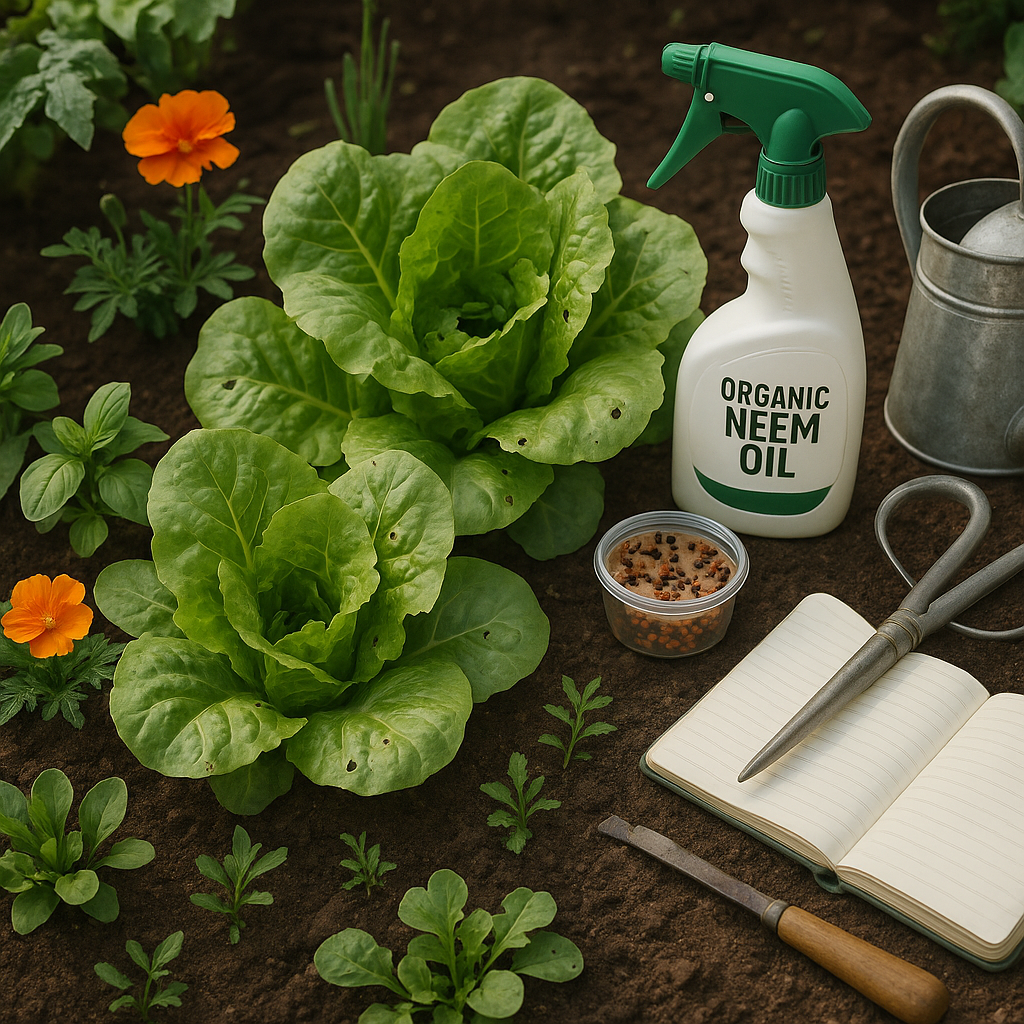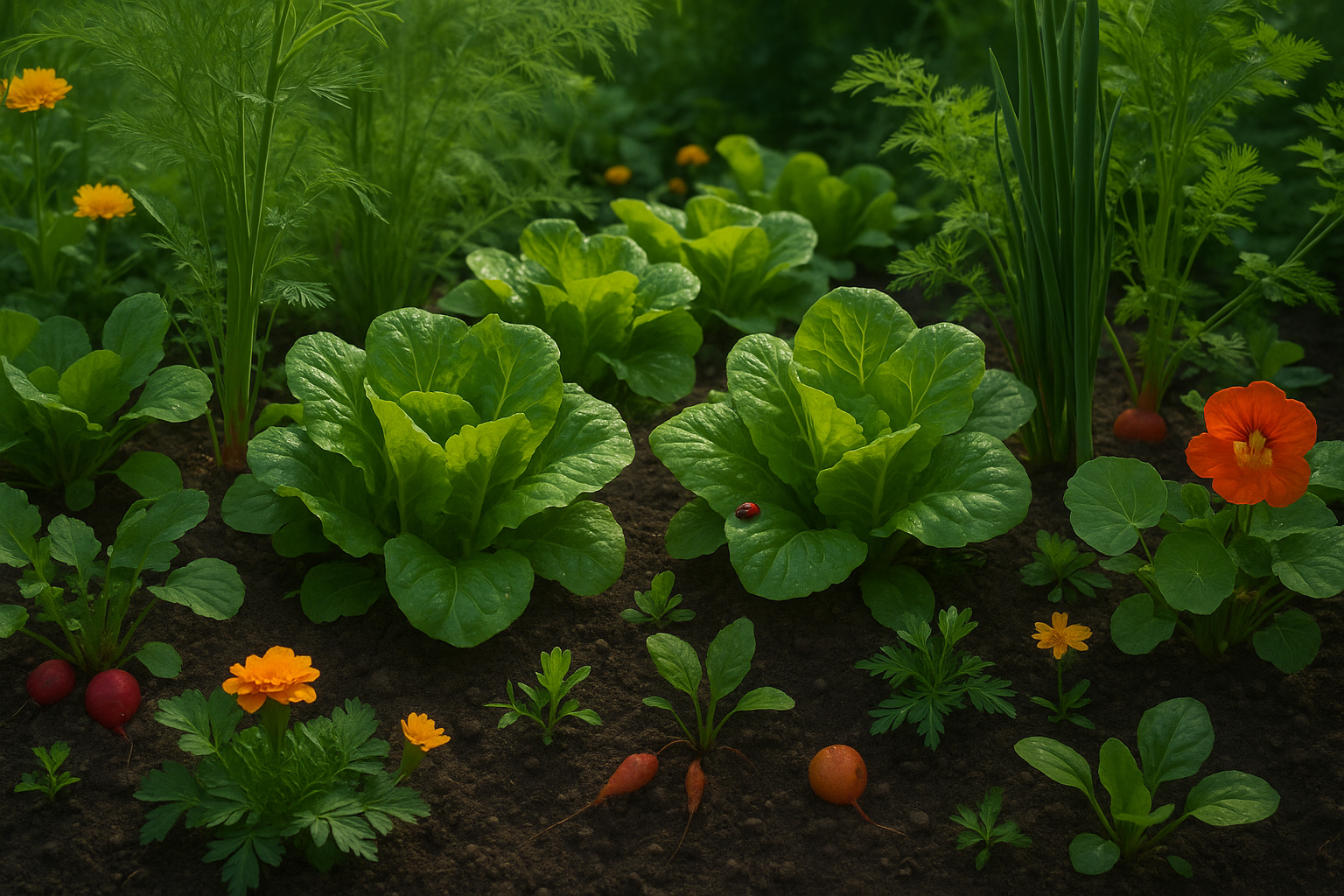Best Companion Plants for Lettuce Growth and Protection
Companion planting is an age-old gardening technique where different plant species are grown close together to boost productivity, deter pests, and enhance flavor—and it’s especially relevant for lettuce growers. Lettuce thrives in cool, moist environments and needs rich, well-drained soil to produce its tender leaves. However, its delicate nature makes it highly vulnerable to pests like aphids and slugs, as well as heat stress that can cause premature bolting.
Because lettuce has shallow roots and requires consistent moisture, maintaining a cool, pest-free environment is key to a steady, healthy harvest. That’s where thoughtful companion planting really shines. By carefully pairing lettuce with the right neighbors—such as radishes, carrots, or fragrant herbs like dill and chives—you can create a microclimate that keeps soil moist, shades lettuce from harsh sun, and naturally deters insects, all without chemicals.
Companion plants not only help repel unwanted bugs with their scents or attract beneficial insects like ladybugs but also maximize your growing space, increasing overall yield and sometimes even enhancing the flavor of your lettuce. For example, interplanting with taller crops can shield lettuce from midday heat, while certain herbs can mask its scent from ravenous pests.
The best part? Companion planting is easy to start, even in small garden beds or container setups. In the next sections, we’ll break down specific plant pairings and provide step-by-step advice to help you create a thriving, resilient lettuce patch with natural allies working right alongside your greens.
Why Companion Plants Benefit Lettuce

Lettuce, while delicious and versatile, can be surprisingly finicky to grow because it’s prone to several common challenges. Aphids and slugs are major headaches—these hungry pests can quickly munch through tender leaves, stunting growth and ruining harvests. Additionally, lettuce bolts in hot weather, sending up flower stalks prematurely and turning crispy leaves bitter. Its need for consistently moist soil only adds to the complexity, as dry conditions can stress the plant and attract even more pests.
That’s where companion planting comes in. By growing lettuce alongside plants like chives, garlic, or marigolds, you harness natural pest deterrents—pungent aromas and compounds these companions release help mask lettuce’s scent, confusing and repelling aphids and slugs without chemicals. Taller, leafy neighbors such as beans or sunflowers can provide welcome afternoon shade, keeping lettuce cool enough to delay bolting and maintain sweet flavor even during warm spells.
Another benefit is moisture retention: dense ground covers like spinach act as living mulch, reducing evaporation and helping maintain the steady soil moisture lettuce craves. However, the chemistry between plants—allelopathy—matters, too. Some companions, like carrots and radishes, release beneficial substances into the soil that actually stimulate lettuce growth. Others, like parsley, can inhibit its development if planted too closely, so plan your combinations with care.
Companion planting also draws pollinators and beneficial insects to your garden, increasing biodiversity and resiliency. Even though lettuce isn’t pollinated by insects, these visitors help manage broader pest populations and create a more harmonious ecosystem.
By thoughtfully pairing lettuce with the right allies, you not only protect and nurture your crop but also foster a thriving, multi-layered garden that works in natural balance.
Top Companion Plants to Grow Alongside Lettuce

Pairing lettuce with the right companion plants can transform your garden into a thriving, low-maintenance ecosystem. Carrots and radishes are unbeatable partners: their roots grow deep, breaking up soil and leaving more nutrients available for lettuce’s shallow roots. Plant radishes between lettuce rows for a speedy harvest—radishes grow quickly, loosening soil and leaving space for lettuce to fill in after they’re picked.
Onions and chives, with their pungent aroma, help deter aphids, slugs, and other pests that target tender lettuce leaves. Incorporate chives at the ends of your lettuce beds and onions in neighboring rows; both also improve overall garden diversity.
Beets are another smart pick, as they don’t compete with lettuce for sunlight or nutrients and offer vibrant color contrasts. Spinach pairs well thanks to similar growing conditions—it’s possible to alternate rows or cluster them in the same bed, ensuring consistent moisture levels and simplifying harvests.
Flowers like marigolds, nasturtiums, and calendula serve as natural pest repellents, attracting beneficial insects like ladybugs and deterring harmful ones. Tuck them in garden corners or intersperse clusters among lettuce for visual appeal and protection. Edible flowers such as nasturtiums also provide shade, which can help reduce bolting in lettuce during warmer months.
Herbs, especially dill and cilantro, are excellent additions: both attract predatory insects that feed on aphids and provide a gentle fragrance that masks the scent of lettuce from pests.
For optimal spacing, aim to keep companion plants 6 to 12 inches apart, depending on their size and growth habit, ensuring enough airflow and access to light. Practice succession planting by sowing new lettuce and companion seeds every two to three weeks; as one crop matures or is harvested, the next fills in, enabling a steady, continuous harvest.
By thoughtfully arranging a mix of leafy greens, root crops, herbs, and flowers, you create a mutually supportive network, leading to healthier, more productive lettuce and a beautiful, functional garden.
Which Plants to Avoid with Lettuce
When planning your vegetable garden, it’s important to know which plants can be bad neighbors for your lettuce. Brassicas like cabbage, broccoli, and cauliflower should be kept away from lettuce because they compete for similar nutrients in the soil, leading to fierce competition that can leave your lettuce stunted or weak.
Parsley and celery are also best avoided in your lettuce beds. Not only do they compete for resources, but their dense growth can overshadow lettuce seedlings and increase humidity. This environment attracts pests and raises the risk of fungal diseases.
Fennel is particularly notorious for stunting the growth of many vegetables, including lettuce. It releases chemicals into the soil that inhibit neighboring plants—a phenomenon known as allelopathy. These combinations can make your lettuce more susceptible to aphids and other pests that thrive on stressed plants.
The best guideline is to avoid mixing lettuce with these heavy feeders and allelopathic plants in the same bed. Instead, opt for companions that benefit lettuce, such as:
- Carrots
- Radishes
- Onions
These plants generally draw nutrients from different soil levels and help deter common lettuce pests. Herbs like dill and chives also make great neighbors, as they attract beneficial insects and don’t compete aggressively for resources.
By steering clear of problem plants and choosing compatible companions, you’ll set your lettuce up for healthy, abundant growth all season long.
Planting Strategies and Layouts for Best Results

Designing a productive lettuce garden starts with thoughtful planting strategies that take advantage of companion planting and efficient layouts. Interplanting rows of lettuce alongside herbs like chives and dill or flowers such as marigolds can deter pests, attract pollinators, and maximize your garden’s space. Adding ground cover flowers like nasturtiums or alyssum acts as a living mulch, suppressing weeds and retaining soil moisture.
For continuous harvest and healthy soil, practice crop rotation by avoiding planting lettuce in the same spot every season. This reduces disease risk and soil depletion. Follow lettuce with legumes (such as bush beans) that enrich the soil, then rotate back after a cycle. Succession planting—sowing a small batch of lettuce seeds every two weeks—ensures a steady supply of fresh leaves year-round, especially when paired with its best companions like carrots or radishes, which mature at different rates but share similar requirements.
Optimizing Small Spaces
Small spaces don’t have to limit your options. Container gardens and raised beds are excellent for tight patios or balconies—simply plant lettuce with beneficial companions such as basil (which repels insects) or onion sets (which take up minimal space and deter pests). A 2-foot by 4-foot raised bed can comfortably hold several lettuce varieties interplanted with low-growing herbs and edible flowers, all while keeping crops accessible.
You can even tuck pots of lettuce at the base of tall tomatoes or peppers, using those plants as living shade to protect lettuce from midsummer heat. Take advantage of existing microclimates by planting lettuce on the north side of corn or sunflowers to shield it from harsh afternoon sun, or near a shrub or fence line to act as a windbreak, reducing leaf damage and water loss. In windy gardens, group containers behind garden furniture or trellises to create a more sheltered spot.
By mixing strategic layouts, companion plants, and microclimate tweaks, you’ll keep lettuce healthy, productive, and pest-resistant throughout every season.
Troubleshooting

Even with the best companion planting intentions, lettuce can still face challenges like persistent pests, sluggish growth, and plant diseases. For example, aphids and slugs often bypass natural plant barriers, while overcrowding can stunt lettuce development or invite mildew.
The first step to healthier lettuce is rethinking your plant pairings. If you notice pest problems, try swapping out companions and adding strong allies like chives, garlic, or marigolds, which are proven to repel common lettuce attackers.
Ensure each crop has adequate space; aim for at least six inches between lettuce and neighboring plants to boost air circulation and allow full sun exposure. Both of these help deter mold and prevent nutrient competition. Regularly rotate companion plants each season to disrupt pest cycles and improve soil health.
Tackle pests organically by gently spraying lettuce with a diluted neem oil solution or releasing beneficial insects like ladybugs and lacewings nearby, which naturally reduce aphid numbers. Diatomaceous earth sprinkled around your plants offers a chemical-free slug deterrent without threatening friendly insects.
When it comes to watering, favor morning routines and avoid wetting the leaves to reduce fungal issues—drip irrigation or soaker hoses are particularly effective here.
Starting your own companion planting system is simpler than it seems: pick a few pest-repellent herbs or flowers suited to your climate, plant them alongside your lettuce, and note which combinations thrive best through each season. Keep a garden journal to track progress and adjust companions as needed, and don’t hesitate to move or replace struggling partners.
With a bit of attention to detail, thoughtful companion choices, and these organic tweaks, your lettuce will flourish—staying healthier, safer, and tastier right up to harvest.
